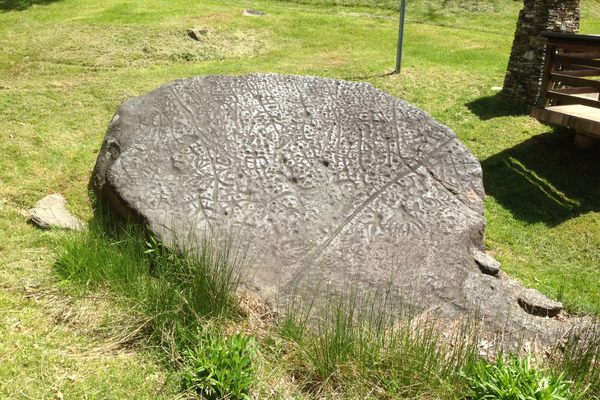A Village in France Will Pay You $2,240 to Decipher a Rock
We hope you like reading in all caps.

If stones could speak, what would they say? According to one rock in a small village in France, “ROC AR B…DRE AR GRIO SE EVELOH AR VIRIONES BAOAVEL.” If those garbled letters mean anything to you, you might find yourself pocketing a few thousand dollars in cold, hard, rock-deciphering reward cash.
The village of Plougastel-Daoulas in Brittany, France, has just posted a reward of 2,000 euros ($2,240) for anyone who can translate this very cryptic message on a very mysterious rock, according to Agence France-Presse. The stone in question stands on the outskirts of Plougastel-Daoulas. Most of the day, it lurks submerged by the Atlantic Ocean, revealing itself only at low tide. The stone was first spotted three or four years ago, but the mystery of its etchings has stumped the local academics who attempted to crack the code, CNN reports.
Approximately the size of an average person (whatever that means), the rock is covered on one side with an inscription almost entirely in capital letters, according to AFP. All the letters come from the French alphabet, but their combinations have proved unreadable. “There are people who tell us that it’s Basque and others who say it’s old Breton,” Dominique Cap, the town’s mayor, told AFP. The rock also boasts two dates, 1786 and 1787, that hint at its age. These years correspond with the years that the town constructed artillery batteries to protect the nearby city of Brest, as Véronique Martin, who is leading the search for a translator, told AFP. The rock also bears a drawing of a sailboat.
Locals frequently compare the rock to one of the world’s most famous mineral mysteries, the Rosetta Stone. The stone, which contains the same decree written in hieroglyphs, Demotic, and Ancient Greek, was discovered in Egypt in 1799. It took 23 years before the French scholar Jean-François Champollion cracked the code of the hieroglyphs. Unfortunately for the future of Plougastel-Daoulas’s particular mysterious rock, Champollion could not be reached for comment or translation, having died in Paris in 1832.
As it awaits translation, the boulder at Plougastel-Daoulas joins a cherished clique of untranslatable stones. In Los Lunas, New Mexico, the 80-ton Decalogue Stone bears inscriptions that still stump scientists and have even convinced some that the rock is a hoax. In Berkeley, Massachusetts, the Dighton Rock hosts elaborate petroglyphs that scholars have attributed to the Vikings, Native American communities, and one Portuguese explorer. In Calva, North Carolina, the Judaculla boulder boasts an intricate web of symbols that still elude translation.
Hopefully this French rock’s more recent provenance will assist any would-be code-crackers in their quest. People have until November 30, 2019, to submit their guesses, at which point a jury from the town will decide which translation is most probable and award the prize. When asked to comment on the contest, the mysterious rock said in a statement, “R I OBBIIE: BRISBVILAR … FROIK … AL.”





















Follow us on Twitter to get the latest on the world's hidden wonders.
Like us on Facebook to get the latest on the world's hidden wonders.
Follow us on Twitter Like us on Facebook